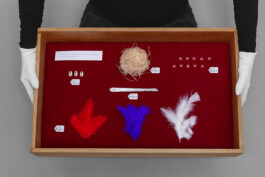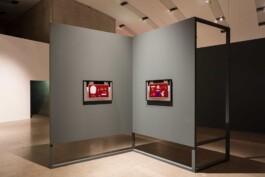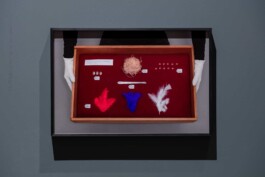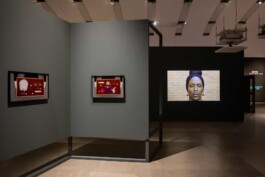
The two-part photographic work In Remembrance to the Man Who Became Known as Angelo Soliman, (Ante Mortem) I & (Post Mortem) II (2015) deals with the museal display of the body of Angelo Soliman (unknown – 1790), a historical figure of eighteenth-century Vienna, in the former k.u.k. Hof-und Naturalienmuseum [Imperial and Royal Court Museum and Natural History Museum]. The man who became known as Angelo Soliman was abducted from the African continent as a child, enslaved, and ended up serving the Prince of Liechtenstein. Immediately following his death, from what was most likely a stroke, his body was stuffed and later exhibited.




© kunst-dokumentation.com / Manuel Carreon Lopez n
© kunst-dokumentation.com / Manuel Carreon Lopez
© kunst-dokumentation.com / Manuel Carreon Lopez
© kunst-dokumentation.com / Manuel Carreon Lopez
In this work, Belinda Kazeem-Kamiński concentrates on items that were assigned to Soliman during his lifetime (ante mortem) and after his death (post mortem). But this diptych does not simply show the display cases containing Soliman’s props: both photographs also feature two arms, with white gloves and black sleeves, that hold the cases, evoking the figure of the custodian or restorer. In creating this effect of “a frame within a frame”, the work insists on the museal apparatus and its relentless logics of collecting, preserving, and exhibiting.
— Anne Faucheret and Belinda Kazeem-Kamiński, 2021

The two-part photographic work In Remembrance to the Man Who Became Known as Angelo Soliman, (Ante Mortem) I & (Post Mortem) II (2015) deals with the museal display of the body of Angelo Soliman (unknown – 1790), a historical figure of eighteenth-century Vienna, in the former k.u.k. Hof-und Naturalienmuseum [Imperial and Royal Court Museum and Natural History Museum]. The man who became known as Angelo Soliman was abducted from the African continent as a child, enslaved, and ended up serving the Prince of Liechtenstein. Immediately following his death, from what was most likely a stroke, his body was stuffed and later exhibited.




© kunst-dokumentation.com / Manuel Carreon Lopez n
© kunst-dokumentation.com / Manuel Carreon Lopez
© kunst-dokumentation.com / Manuel Carreon Lopez
© kunst-dokumentation.com / Manuel Carreon Lopez
In this work, Belinda Kazeem-Kamiński concentrates on items that were assigned to Soliman during his lifetime (ante mortem) and after his death (post mortem). But this diptych does not simply show the display cases containing Soliman’s props: both photographs also feature two arms, with white gloves and black sleeves, that hold the cases, evoking the figure of the custodian or restorer. In creating this effect of “a frame within a frame”, the work insists on the museal apparatus and its relentless logics of collecting, preserving, and exhibiting.
— Anne Faucheret and Belinda Kazeem-Kamiński, 2021
© Belinda Kazeem-Kamiński 2025